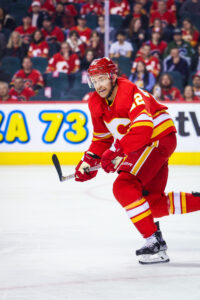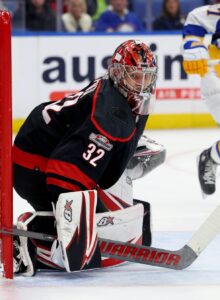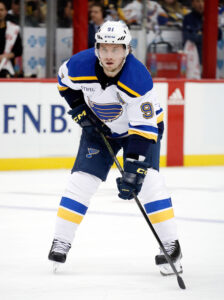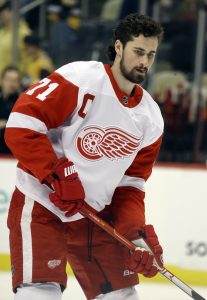Topics in this edition of the PHR Mailbag include what Seattle might do to add before the deadline, how Dallas could be an intriguing team to keep an eye on, if there’s a trade market for Anthony Mantha, and more. If your question doesn’t appear here, check back in last weekend’s two mailbag columns.
Grocery stick: What would the Blackhawks do with Connor Bedard? If they keep trading away everyone, is Bedard supposed to play with wingers like Mackenzie Entwistle and Boris Katchouk? Should I keep my fingers crossed anyone else wins the lottery?
This is a question I’ve wondered myself for a few possible lottery winners. When you get a potential franchise player, the last thing a team should want to do is to waste his three cheap seasons by continuing to aim to finish at the bottom of the standings. If Bedard pans out as many expect him to, his second contract is going to be a pricey one, probably in the double-digit AAV range. It’s much easier to try to win when that player is capped at a $1MM base salary on an entry-level deal.
For Chicago specifically, I don’t think winning the lottery would necessarily end the rebuild and the spending would start right away to add some quality talent around him. However, I do think it would expedite what otherwise is likely to be a multi-year process.
Next season, I wouldn’t expect much to change. I think they’ll want to add a capable veteran or two (or perhaps re-sign a certain duo if they opt not to be dealt) to insulate Bedard a little bit but the goal will still be tanking so their current wingers would still likely be part of the lineup. In 2024-25, Frank Nazar might be ready to turn pro after his freshman year this season was cut short due to injury and Lukas Reichel should be a full-timer by then. They’ll also be armed with ample cap space and what should be a pretty good selling point (come play in a strong market with the next great star) to help attract some quality veterans. That’s not enough to become an immediate contender but they might be able to get to the playoffs. From there, 2025-26 would be their ‘go for it’ year before Bedard’s contract would start to become more of an obstacle.
aka.nda: How big do the Kraken dare to dream about their postseason?
I don’t expect GM Ron Francis to be dreaming too big here. Part of the logic for Seattle hiring him was the slow and steady approach he has for roster building. This is only their second year and I don’t think he feels that they’re at a spot where it’s time to flip a switch, consolidate some assets into more impact pieces, and really go for it.
There’s a big question that stands out to me that make it difficult to justify loading up too much, their goaltending. Martin Jones isn’t a true starting goalie, Philipp Grubauer is still underachieving, and even when Chris Driedger returns from his season-long injury, he’s not a real starter either. They’re not going to go trade for yet another goalie and it’s hard to think someone in that triumvirate is going to carry them to postseason success. With that in mind, it’s probably not the right time to load up.
They’ve already made their depth move on the back end with the addition of Jaycob Megna from San Jose. I could see them aiming for a third-line forward signed beyond this year with Toronto’s second-rounder being in play (a non-rental makes it easier for them to justify parting with the pick) but that’s about the extent of the buying I expect them to do.
The Duke: Oh, Supreme Soothsaying Spheroid, I humbly seek your wise fortune-telling: 1. Does Horvat somehow resurrect Barzal’s scoring? 2. Luke Hughes rumored up with Devils in early March; does he make their PP? 3. Does Tarasenko stay or go – and to where n’ for whom? 4. Same Q regarding Laine?
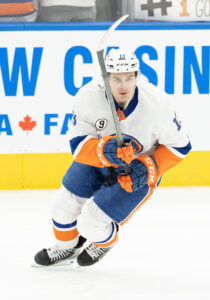 1) If you mean scoring in terms of goals, probably not. Mathew Barzal just isn’t a goal scorer; he’s a playmaker. It doesn’t matter who you put with him, he’ll hover around the mid-teens for goals; he’s just not a high-end shooter. But what Bo Horvat should do is balance things out. The Isles now have two capable scoring lines with some players that can be shifted around. In the long term, that’s going to help their offense and, by extension, help Barzal’s point total. If he’s on the wing with Horvat as he is now, that line should score more. If Barzal’s on the second line and Horvat’s line is drawing the tighter checkers, that should make it a bit easier on Barzal. Long story short, the trade should help Barzal’s assist total but I wouldn’t expect his goal total to change much.
1) If you mean scoring in terms of goals, probably not. Mathew Barzal just isn’t a goal scorer; he’s a playmaker. It doesn’t matter who you put with him, he’ll hover around the mid-teens for goals; he’s just not a high-end shooter. But what Bo Horvat should do is balance things out. The Isles now have two capable scoring lines with some players that can be shifted around. In the long term, that’s going to help their offense and, by extension, help Barzal’s point total. If he’s on the wing with Horvat as he is now, that line should score more. If Barzal’s on the second line and Horvat’s line is drawing the tighter checkers, that should make it a bit easier on Barzal. Long story short, the trade should help Barzal’s assist total but I wouldn’t expect his goal total to change much.
2) Assuming Hughes does turn pro as expected and is in New Jersey’s lineup, it wouldn’t make a lot of sense if he wasn’t on one of their power play units. If you’re going to put someone into the lineup straight out of college, putting that player in a position to succeed is critical. He’s quite comfortable and productive on the man advantage at Michigan so it would make sense to play him on the second unit with the Devils. Damon Severson is in that spot at the moment but only has four goals (none of which were on the power play) so it’s not as if that spot can’t be upgraded.
3) Well, we all know the answer to this one now as Vladimir Tarasenko is with the Rangers as the crystal ball predicted back in December.
4) There isn’t much of a reason to think Patrik Laine is going anywhere over the next few weeks. It was a big deal for them to get Laine to give up a few UFA years on his last contract so why would they move him in the first year of that? Yes, things haven’t gone well at all and there will be changes coming but it’s not going to be their top guys that move. Laine (and Johnny Gaudreau) should be around for a couple more years at least.
@JasonClausen7: Are the Stars pretty much handcuffed this trade deadline? It seems the Benn and Seguin contracts have stopped them from being able to do anything lately. Benn’s resurgence has been great but what’s happened to Seguin? Will he ever be better than this?
I actually think Dallas is in reasonable shape compared to some other potential buyers. Barely having $1MM in cap room (per CapFriendly) isn’t much to work with but it’s better than quite a few teams. On top of that, they have an expiring offset contract in Anton Khudobin who’s counting on the books at $2.208MM while he’s in the minors. Most contenders don’t have a veteran roster player that they’d want to move out but Khudobin, who isn’t on the roster at all, is an easy exception. Include him in a trade and all of a sudden, that ups their spending capital past the $3MM mark and if the trading team is retaining up to the maximum of 50%, now we’re talking about a $6MM player. That gives them some options so I don’t see them being handcuffed.
As for Tyler Seguin, I don’t see a big resurgence coming. He’s averaging 0.66 points per game this season. If we expand that timeline back to his average since 2018-19, it’s at 0.66 points per game. This is basically who he is now, a second liner that, if he’s healthy, should average between 50-55 points in a season. That’s still a pretty useful player all things considered. Don’t get me wrong, the contract is lousy and is probably one of the worst in the league. But at the very least, he’s still a more than serviceable player.
Devil Shark: I know it’s early(ish) but… Is 2018 the biggest bust draft this millennium?
By a quick look, there are about three top-tier players out of the whole draft and a few bit players which seems incredibly weak. I’ve seen a lot of debate about the top drafts of the past 20 years… but what about the worst?
Thanks in advance.
The top-end depth of this draft is okay in Rasmus Dahlin, Quinn Hughes, Andrei Svechnikov, and Brady Tkachuk. That’s not bad and all those players are still on an upward trajectory. Perhaps there isn’t a superstar in the mix but those are some quality core players that will have long careers. But there is definitely some fall-off after that as Jesperi Kotkaniemi, Barrett Hayton, and Filip Zadina (all top-six picks) have been depth players at best thus far. There have been some good value picks (Noah Dobson at 11, Joel Farabee at 14, and K’Andre Miller at 22 among the first rounders) but even at that, that’s not that special compared to other seasons.
I think I’d nominate 2012 as a bigger bust of a draft than 2018. Nail Yakupov was a bad pick at first overall. Ryan Murray is no more than a depth defender now, he was the second pick. Alex Galchenyuk’s in the minors after bouncing around the last few years (and is still fifth in scoring from this group). The fourth pick, Griffin Reinhart, never scored a single NHL goal. Now, there have been some good value picks from that class that have given it some depth (Filip Forsberg, Tomas Hertl, and Teuvo Teravainen were all picked in the middle third of the first round) and there are 21 players (and counting) with at least 500 NHL appearances. That helps. But 2018’s group should eventually get to that level within the next six years (where it could be better compared with 2012’s class today) and at least the first couple of picks (Dahlin and Svechnikov) are panning out to be high-end pieces. That just can’t be said for the 2012 group.
